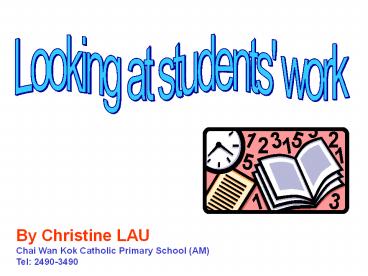Looking at students' work PowerPoint PPT Presentation
Title: Looking at students' work
1
Looking at students' work
By Christine LAU Chai Wan Kok Catholic Primary
School (AM) Tel 2490-3490
2
Why?
Curriculum planning material design
3
When?
Every day?
Once a term?
Once a year?
Too late? Too frequent? How to strike a balance?
4
How?
Quantitative analysis?
All parts?
Selected parts only?
Qualitative analysis?
Both?
NO prescribed mode
Primary concern Looking for patterns in
students work and understanding why the students
make mistakes (Misconception? Laziness?
Carelessness? Not taught before? Lack of input?
Infrequent practice / recycling? )
5
What NEXT?
- Re-teaching / re-cycling in the next module
- Careful scaffolding
- Change in teaching strategies
- Designing worksheets etc.
Be specific, explicit and clear
6
Answering yes/no questions
7
(No Transcript)
8
(No Transcript)
9
(No Transcript)
10
(No Transcript)
11
(No Transcript)
12
Some students fail to give their short answers
using the correct auxiliary verbs
13
Four steps in giving short answers to yes/no
questions
- Determine whether the answer should be Yes or
No. - Write down the subject pronoun.
- Copy the auxiliary verb directly from the
question. - If the answer is No, add not (i.e. negation)
right after the auxiliary verb (and produce an
abbreviated form).
- e.g. Do Ann and Sam like reading poems?
- Yes,
- Yes, they
- Yes, they do.
- No, they do not. (gt No, they dont.)
14
Answering open-ended questions
15
1st Term Test 1 (October 03)
16
(No Transcript)
17
(No Transcript)
18
(No Transcript)
19
(No Transcript)
20
- The question What do you think of ? has been
introduced in the lessons before and is used 3
times in this test. About half of the students
can describe peoples character appropriately
though the rest show very little understanding of
the questions. - Less than half of the students can give
appropriate answer to the last question which is
open-ended. Most of them like Tom most.
21
An activity sheet is designed so that students
can practise using different adjectives to
describe peoples character. An open-ended
question is also included in the worksheet.
22
1st Term Test 2 (November 03)
23
(No Transcript)
24
(No Transcript)
25
(No Transcript)
26
(No Transcript)
27
(No Transcript)
28
(No Transcript)
29
Teachers continue to add in 2 open-ended
questions, Q6 Q7, in Part I (Reading
Comprehension) of the Test Paper. This time, more
than half of the students can provide appropriate
answers. There is slight improvement compared to
Test 1.
30
1st Term Exam (January 04)
31
(No Transcript)
32
(No Transcript)
33
Most students can give appropriate answers for
the last question which is not direct lifting
34
2nd Term Test 3 (March 04)
35
(No Transcript)
36
(No Transcript)
37
(No Transcript)
38
(No Transcript)
39
(No Transcript)
40
2nd Term Test 4 (May 04)
41
(No Transcript)
42
There are three open-ended questions out of six.
43
- Q4 Which child do you like best? Why?
- I like Sue best because she is nice.
- I like Tom best because he is hardworking and
good boy. - I like Sue best because she is helpful.
- I like Charlie best because I like play football
too. I like David best because happy boy. - I like Tom best because good bay.
- I like Tom best because she is hard work.
- I like Ann best because she likes read a book.
She is a good girl. - I like May best because she read a book.
(describing the fact only) - I like Ann best because she on Monday, Tuesday
and Friday read a book. (trying to emphasize but
failing to infer) - I like David best because he is happy. I like Sue
best because she is clever. (not relevant) - I like David best because he is starg
(i.e.strong). (not relevant)
44
- Q5 When do you watch TV?
- I watch TV at five oclock in the afternoon.
- I watch TV at half past three in the afternoon.
- I watch TV on Sunday.
- I watch TV on Sunday afternoon.
- I watch TV everyday.
- She watch TV on Monday.
- Yes, I am.
- May.
45
2nd Term Exam (June 04)
46
(No Transcript)
47
(No Transcript)
48
(No Transcript)
49
(No Transcript)
50
(No Transcript)
51
(No Transcript)
52
For Q5, nearly all students attempt to give their
own answer, and most answers are sensible. Only a
few are irrelevant.
53
Comparing students performance in these 6 tests
and exams
54
What are students problems in learning?
How can students learn better?
55
Mixing up the letter sounds b d
56
Not knowing that Mr and Mrs Wong are two persons
57
Misspelling the (irregular) plural form of child
58
Subject-verb agreement (esp. for irregular verbs
like go/goes, do/does have/has)
59
Some students make mistakes in Q4 Q5 probably
because the subject and the verb are not on the
same line.
60
For Q4, several students even add They to the
beginning possibly because they see Ann and Sam
on the same line.
61
For Q3, some students misspell patting as
pating.
62
Not knowing the irregular form of have
63
Thanks

